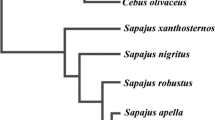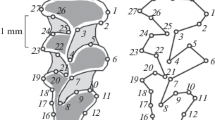Abstract
We measured canine teeth from 28 woolly spider monkeys (Brachyteles arachnoides) to assess sexual dimorphism and population differences. The specimens are from the Brazilian states of Bahia, Minas Gerais, Espírito Santo, Rio de Janeiro, and São Paulo. We found strong sexual dimorphism in canine length for individuals belonging to populations south of 22°00′ latitude but no sexual dimorphism in canine length from individuals of populations north of 21°00′ latitude. Canine length did not vary among females of northern and southern populations. However, southern males had significantly longer canines than northern males. This geographical difference in canine morphology, together with the presence or absence of thumbs and published accounts of differences in genetics and social structure between northern and southern populations, suggests thatBrachyteles arachnoides may be composed of at least two subspecies, which appear to be separated by the rivers Grande and Paraiba do Sul and the Serra da Mantiqueira.
Similar content being viewed by others
References
Assumpção, C. T. (1983). Ecological and behavioral information onBrachyteles arachnoides.Primates 24(4): 584–593.
Fonseca, G. A. (1983).The Role of Deforestation and Private Reserves in the Conservation of the Woolly Spider Monkey (Brachyteles arachnoides), M.Sc. thesis, University of Florida, Gainesville.
Fonseca, G. A. (1985). Observations on the Ecology of the muriqui (Brachyteles arachnoides E. Geoffroy 1806).Primate Conserv 5: 48–52.
Fonseca, G. A., Lemos de Sá, R. M., Pope, T. R., Glander, K. E., and Struhsaker, T. T. (1991). A pilot study of genetic and morphological variation in the murique (Brachyteles arachnoides) as a contribution to a long term conservation management plan. Unpublished report to Conservation International and Wildlife Preservation Trust International.
Kay, R. F., Plavcan, J. M., Glander, K. E., and Wright, P. C. (1988). Sexual selection on canine dimorphism in New World monkeys.Am. J. Phys. Anthropol. 77: 385–397.
Lemos de Sá, R. M. (1988).Situação de uma População de mono-carvoeiros, Brachyteles arachnoides,em Fragmento de Mata Atlântica (M.G.), e Implicações para sua Conservação, M.Sc. thesis, Universidade de Brasília.
Lemos de Sá, R. M., and Glander, K. E. (1993). Capture techniques and morphometrics for the woolly spider monkey, or muriqui (Brachyteles arachnoides, E. Geoffroy 1806).Am. J. Primatol. 29: 145–153.
Lemos de Sá, R. M., and Strier, K. B. (1992). A preliminary comparison of forest structure and use by two isolated groups of woolly spider monkeys (Brachyteles arachnoides).Biotropica 24: 455–459.
Milton, K. (1984). Habitat, diet and activity patterns of free-ranging woolly spider monkeys (Brachyteles arachnoides E. Geoffroy 1808).Int. J. Primatol. 5: 491–514.
Milton, K. (1985a). Mating patterns of wooly spider monkeys,Brachyteles arachnoides: implications for female choice.Behav. Ecol. Sociobiol. 17: 53–59.
Milton, K. (1985b). Urine washing behavior in the woolly spider monkey.Z. Tierpsychol. 67: 154–160.
Mittermeier, R. A., Valle, C. M. C., Alves, M. C., Santos, I. B., Pinto, C. M. A., Strier, K. B., Veado, E. M., Constable, I. D., Paccagnella, S. G., and Lemos de Sá, R. M. (1987). Current distribution of the muriqui in the Atlantic forest region of eastern Brazil.Primate Conservation 8: 143–148.
Nishimura, A. (1979). In search of woolly spider monkey.Reports of New World Monkeys, Kyoto University Primate Research Institute, pp. 21–37.
Pope, T. R. (1993). Genetic variation in remnant populations of the woolly spider monkey: Implications for conservation.Conserv. Biol. 9submitted for publication).
Rosenberger, A. L., and Strier, K. B. (1989). Adaptive radiation of ateline primates.J. Hum. Evol. 18: 717–750.
Strier, K. B. (1986).The Behavior and Ecology of the Woolly Spider Monkey or Muriqui (Brachyteles arachnoidesE. Geoffroy 1806), Doctoral dissertation, Harvard University, Cambridge, MA.
Strier, K. B. (1987a). Ranging behavior of woolly spider monkeys, or muriquis,Brachyteles arachnoides.Int. J. Primatol. 8: 575–591.
Strier, K. B. (1987b). Activity budgets of woolly spider monkeys, or muriquis (Brachyteles arachnoides).Am. J. Primatol. 13: 385–395.
Strier, K. B. (1987c). Reprodução deBrachyteles arachnoides. In de Mello, M. T. (ed.),A Primatologia no Brasil, Vol. 2, Universidade de Brasília, Brasília, Brasil.
Strier, K. B. (1989). Effects of patch size on feeding associations in muriquis (Brachyteles arachnoides).Folia Primatol. 52: 70–77.
Strier, K. B. (1991a). Diet in one group of wooly spider monkeys, or muriquis (Brachyteles arachnoides).Am. J. Primatol. 23: 113–126.
Strier, K. B. (1991b). Demography and conservation of endangered primates.Conserv. Biol. 5: 214–218.
Zingeser, M. R. (1973). Denition ofBrachyteles arachnoides with reference to Alouattine and Atelinine affinities.Folia Primatol. 20: 351–390.
Author information
Authors and Affiliations
Rights and permissions
About this article
Cite this article
Lemos de Sá, R.M., Pope, T.R., Struhsaker, T.T. et al. Sexual dimorphism in canine length of woolly spider monkeys (Brachyteles arachnoides, E. Geoffroy 1806). International Journal of Primatology 14, 755–763 (1993). https://doi.org/10.1007/BF02192189
Received:
Revised:
Accepted:
Issue Date:
DOI: https://doi.org/10.1007/BF02192189




